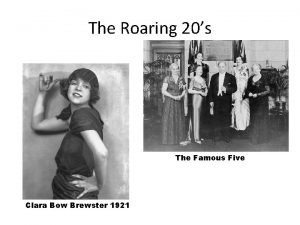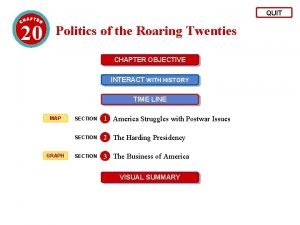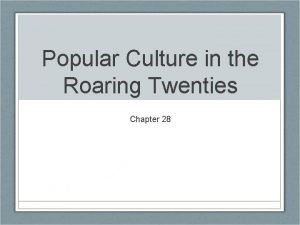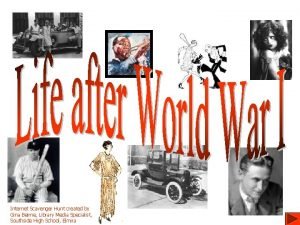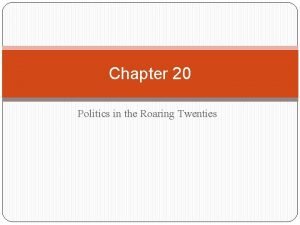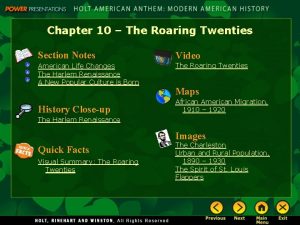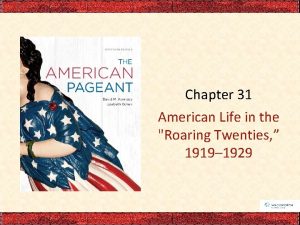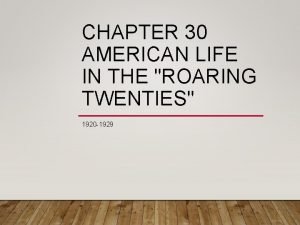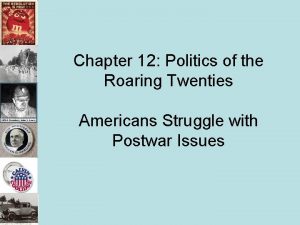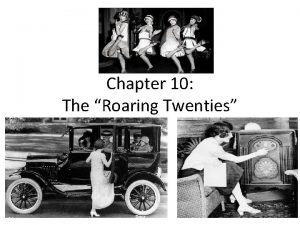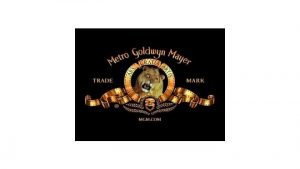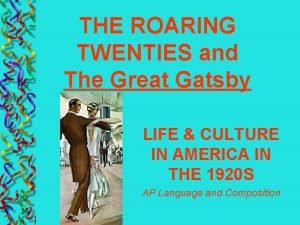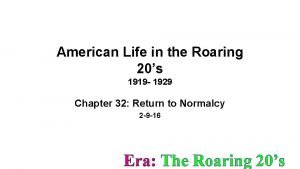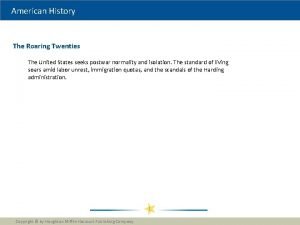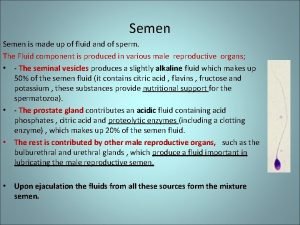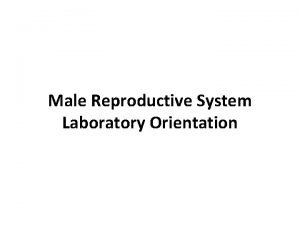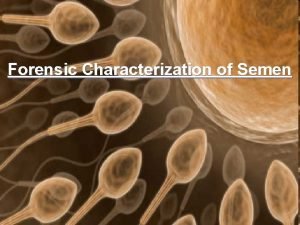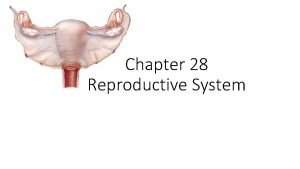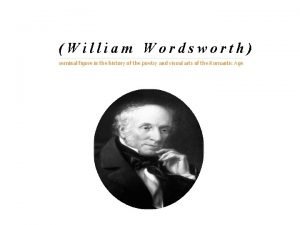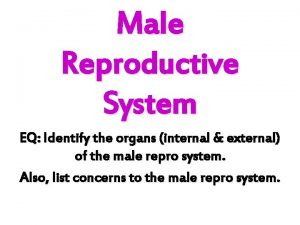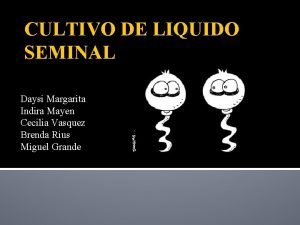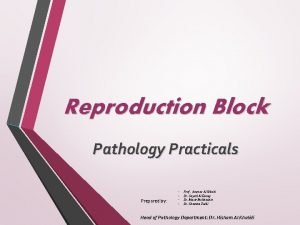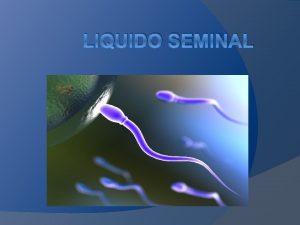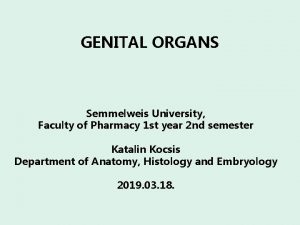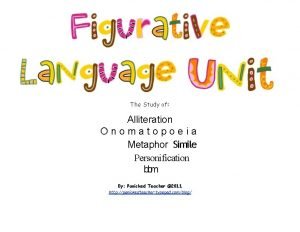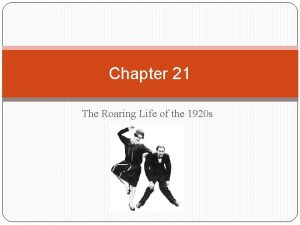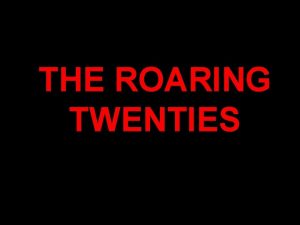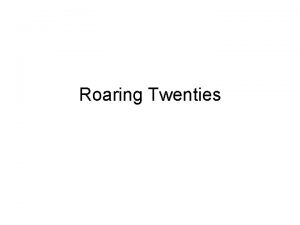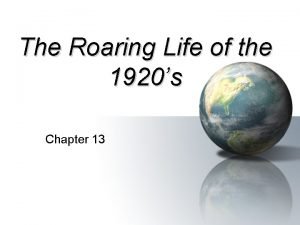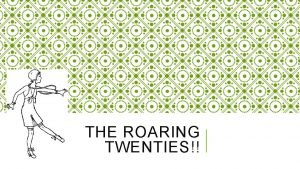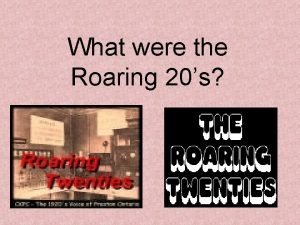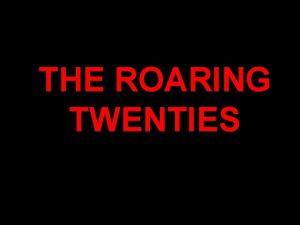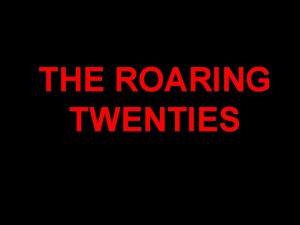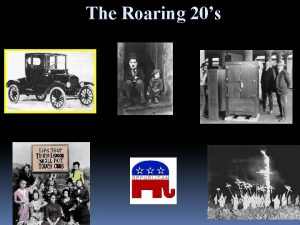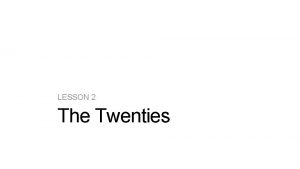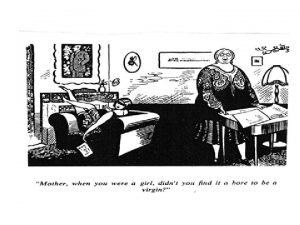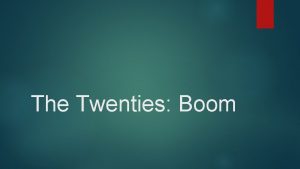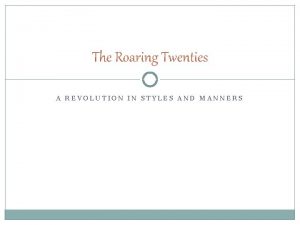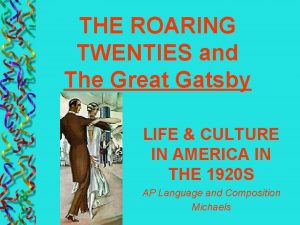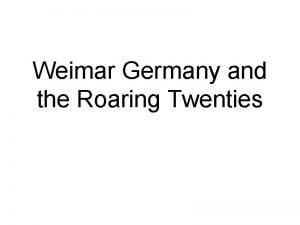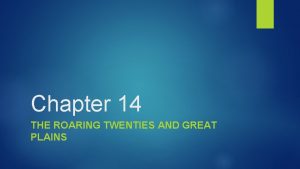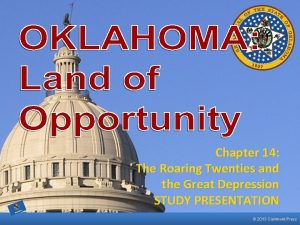The Roaring Twenties And its Seminal Issues The







































- Slides: 39

The Roaring Twenties And its Seminal Issues The Politics Of Frustration And The Politics of Prohibition

Not All is Well in Gotham • Not everyone benefited from the “Politics of Prosperity. ” • Ex-Servicemen had difficulty finding jobs; • Huge upswing in Racism and Xenophobia; • Many desired a return to “The Good Ol days. ”

Gotham is troubled • Warren G. Harding promoted a “Return to Normalcy. ” • What sort of normalcy? Did America return to normalcy? • Distinguish between cultural fundamentalism and religious fundamentalism. • Define “invisible empire” and “Americanism. ”

“Good Ol’ Days” • People began to write and yearn for a “Bygone America. ” • Free of labor and racial strife • Fewer “Foreigners. ” • No radical ideologies (ostensibly there was a time everyone got along). • A return to the small town America atmosphere • A more devout citizenry, Christianity. • Less government interference in their daily lives

Return to Normalcy • Associated with the notion of returning to the good old days … Harding run on the normalcy platform; Return to Normalcy included three major trends not really intended: • 1) Redefinition of “Americanism” • 2) Resumption of racial antagonism. • Resurrection of “Old Time Religion. ”

Cultural Fundamentalism • H. L. Mencken was the spearhead of this movement: • Be more European; forget the Puritanism of American society, stamp out anti-intellectualism, we must have some Conformity. Liberalism is needed for this backwards dull-witted American population.

Henry Louis Mencken • Journalist and Editor and Social Critic (Jewish). • He hated all things American —assumed they were dullwitted; • Abhorred the South and the West; He coined the term “Bible Belt” and “Monkey Trial” • “No one ever went broke underestimating the intelligence of the American People. ”

Culture of Fundamentalism • Many people seemed to believe that all the consumerism and cultural decadence was a scourge from God—needed to get back to the fundamentals of Christian tenets. A certain pattern of thought: • Quest for certainty and predictability in social relationships. • An order in human affairs that was at once familiar, comfortable, and unthreatening. • Nostalgia for the idealized, non-industrialized society of their parents.

Politics of Frustration • Begins with suspicion of anything foreign— driving force behind some notorious events; We will focus on four (4): The Red Scare Sacco and Vanzetti Trial The New Ku Klux Klan The Scopes “Monkey” Trial

Red Scare • WWI saw the fall of the Kaiser, the rise of the Communist in Russia; the fall of older more nationalist empires and the rise of influence of communism all across Europe. • The Bolshevik or October Revolution of Nov 1917 saw the rise of Lenin and the Communist International.

The Red Scare • The U. S. and other European countries were facing labor unrest—the Communist League was gaining adherents—such as Eugene V. Debbs of the American Communist/socialist league in America — • The real issue Russia was embroiled in a civil war and the Communist party neither had the material nor the resources to fight or influence World labor unions. Few people knew lenin, and even fewer had heard of Karl Marx.

The Red Scare • Did however, fear the corruption of the Labor Unions— seem to instigate mob violence and labor unrest. • Huge increase in labor strikes and unrest in 1919 fueled this fear. • Seattle was on general strike, Boston police force and a nationwide steel strike was on going. • Many were recent immigrants from eastern and southern Europe, semi and unskilled—many labeled these strikes un-American and were filled with radical anarchists.

The Red Scare • Coincidentally, there were bomb threats to US Senator Thomas Hartwick —exploding mail, which killed his unsuspecting maid. • Others were caught and headed off—going to JP Morgan, JD Rockefeller, Justice Oliver Wendell Holmes—no real evidence that the Bolsheviks were responsible

Palmer Raids • Attorney General A. Mitchell Palmer was also threatened— he suspended the writ of habeas corpus, organized a crime fighting unit, which was headed by a young lawyer—J. Edgar Hoover. • Began to round up communists and anarchists and place them in jail—began deporting many, used the Sedition Acts to make it legal. • By 1920, he had arrested about 3000 people—many were innocent, even Jane Addams of Hull House was suspected of Communist sympathizing

Palmer Raids • Denounced the League of Women Voters as anarchists; • Even began to offend many conservatives; • Palmer used his raids as proof he was tough on communism and ran for the Presidency—but did not get the nomination. • Hoover, under Harding, became Director of the Bureau of Investigation later the FBI

Sacco and Vanzetti • Public distrusted Foreigners; especially anarchists; • Arrested for robbery and murder; • Travesty of Justice—selfproclaimed radicals— essentially were considered guilty before trial—true test of democracy was to protect rights of those who hold separate beliefs

Sacco and Vanzetti • Delicate and sensitive trial—went on for 6 years; • Found guilty and were executed—Vanzetti claimed he was on trial for his beliefs not the act of murder. • “I am suffering because I am a radical. Indeed I am radical. I have suffered because I am an Italian. Indeed, I am an Italian … But I am so convinced to be right … you could execute me twice … I would live again to do what I have already done …”

Rise of the New KKK • After Sacco and Vanzetti, many became disillusioned with Cultural Fundamentalism and began to join more radical sects. • The Ku Klux Klan first emerged during reconstruction. 1915, Col. William Joseph Simmons revived the organization—the KKK received a charter from the Georgia legislature; • However, it remained insignificant until 1920.

KKK • Two NY con men started a southern chapter and publicly promoted the Klan’s views; • The GA legislature began to investigate in 1921— unfortunately the investigation gave much free publicity; • Membership grew from 100, 000 to 1 million in 1922— by 1925, 2 million members. • Promoted 100% Americanism

100% Americanism • Protestantism • Charity • Motherhood • Morality • Temperance • Education

KKK • Officially denied all hatreds, but qualifications for membership embraced all hatreds. • Catholics—Pope a political autocrat—world dominion; • Jews—internationalists who could never truly love America—they killed Jesus; • African Americans— militantly anti-Black

KKK • Not relegated to the Deep South; greatest public support was Texas, Indiana, and Ohio. • Many served on city councils, state legislatures. • Chicago, Indianapolis, Denver and Dallas had Klan mayors; • 6 Governors including Indiana, Oregon and Colorado.

Demise of the KKK • By 1925, membership began to fall off. • Leaders promised too much; • Never had a true systemic organization to influence public opinion; • Never could truly force docility on the African Americans—they fought back. • It relied too much on passion and not enough on reason

Scopes Monkey Trial • On the surface, it was about academic freedom. • It really pitted two societal views; • The urban, modern intellectual rationalism and secularism vs. the religious conservative rural traditional values. • Tennessee Legislature passed a law forbidding the teaching of evolution or any theory conflicting with the Biblical World View. • John T. Scopes, 25, Dayton Tenn High school

Scopes Monkey Trial • Clarence Darrow, secularist lawyer, defended Scopes (ACLU); • Prosecutor was William Jennings Bryan—Cross of Gold Speech and Populist and self-proclaimed leader of the fundamentalist movement; • Scopes lost, charged 100 fine, Bryan died 5 days after the trial—very sensational—pitted evolution and rationalism Vs. Bible.

Fundamentalism • The name comes from a series of pamphlets entitled: The Fundamentals: A Testament of Truth • Authors were Milton and Lyman Stewart between 1909 and 1912. Principles are as follows: • The Virgin Birth of Jesus Christ • Jesus’ Physical Resurrection • The second Coming was imminent and physical • The Bible is literally and figuratively true—there are no allegories, not open to interpretation.

Prohibition • 1920 s a decade of conflicts and contrasts— sexual freedom, behaviors and dress clashed with a new Puritanism. (Decline of Anglo-Saxon Class) • Old traditional values clashed with new urban modernity—Freud and his Libido and love of self; • Termed a glorious orgy: songs-”Hot Lips” “I Need Lovin” to movies “Up in Mabels Room” and “Her Purchase Price. ” Much scandal.

Prohibition • To maintain some Puritan control on social America, the 18 th amendment was passed and ratified by ¾ of the state legislatures forbidding the manufacture or sale of alcoholic beverages in America. • Called the Volstead Act of 1919 (National Prohibition Enforcement Act) gave the 18 th amendment some teeth—by defining an alcoholic drink as any with a content of 0. 5%.

Define Anglo-Saxon Class • 1) True Americans descended from early Western European settlers (English, German, Irish, • • • Scandinavian); 2) The most respectable and responsible of the community; 3) Small-town dwellers 4) Educated people 5) Protestants 6) Republicans 7) Wanted less government in society and economy

Anglo-Saxon Grip • Immigration restriction—Harding and Coolidge both passed laws limiting immigration to America. • Anti-Semitism—considered the Jews the most responsible for world unrest (Henry Ford) very anti-Semitic. • KKK—to help combat immigration, Jews, Catholics and Blacks. • Economic Control—wanted to maintain its hold on corporate America—community clubs. Country clubs, high end segregation and control of colleges and many charities.

Melting Pot Bubbles • However, demographics were changing. • Birth rate of immigrants and native born increasing. • 1911, 2 of every 3 school children had immigrant parents. • Newbies settled in high states with many electoral votes—became politically significant. • Republicans ignored the needs of the growing immigrant class—found themselves on the wrong end of the birth rate—many turned to the democratic party.

Election of 1928 • Very significant—we see the great divide in American demographics. • 1) Immigration had been restricted, but 6. 5 million(internal immigration) rural people moved to the cities—cities very powerful politically. • 2) democrats catering to these new arrivals and old immigrants broke the power of the republican party on national politics. • 3) Presidential candidates represented the transformation under way (Rep: Herbert Hoover [aristocrat]) Alfred E. Smith, lower class Catholic and a self-made man through the political machinery of New York politics. Smith disavowed prohibition.

Back to Prohibition • Not a new phenomenon. Remember the Temperance League—The Women’s temperance Chriatin Union—tried to prove scientifically how bad alcohol was the country. • They utilized Eugenics suggesting heredity was a cause for alcoholism—needed to selectively breed this illicit gene out of the gene pool; • Immigrants and Blacks were inferior therefore susceptible to profusive drink.

Anti-Saloon League • Est. 1896, focused on the legal prohibition of drink; developed a powerful congressional Lobby; • By 1918, 28 states had state laws against drinking (Dry States); • Use prohibition to also attack political bosses and political machines

Typical Prohibitionist • Rural or small Town Person; • Middle Class; • Anglo-Saxon; • Evangelical Protestant; • Embraced Eugenics, fearful of • African Americans, Jews, • Immigrants and Catholics

WWI and Prohibition • War time hysteria against all things foreign linked prohibition to Patriotism. • Centralization of government power—many saw the government as the upholder of American morality, temperance and sobriety—in other words abridge some liberties in the name of mmoral social responsibilities. • The end result was failure—trying to impose a unique brand of social morality backfired—many Americans enjoy drink and were quite willing to break the law to obtain it—created a whole industry of Syndicated and organized crime.

Organized Crime

Organized Crime

Alfonse Capone
 The roaring 20's were characterized by
The roaring 20's were characterized by Roaring twenties acrostic poem
Roaring twenties acrostic poem Chapter 20 politics of the roaring twenties answer key
Chapter 20 politics of the roaring twenties answer key Chapter 28 popular culture in the roaring twenties
Chapter 28 popular culture in the roaring twenties Roaring twenties scavenger hunt answers
Roaring twenties scavenger hunt answers Chapter 20 section 2 the harding presidency
Chapter 20 section 2 the harding presidency Chapter 10 the roaring twenties
Chapter 10 the roaring twenties Chapter 31 american life in the roaring twenties
Chapter 31 american life in the roaring twenties Chapter 30 american life in the roaring twenties
Chapter 30 american life in the roaring twenties Chapter 12 politics of the roaring twenties
Chapter 12 politics of the roaring twenties Chapter 10 the roaring twenties
Chapter 10 the roaring twenties The roaring twenties canada
The roaring twenties canada Roaring twenties great gatsby
Roaring twenties great gatsby Chapter 20 politics of the roaring twenties
Chapter 20 politics of the roaring twenties Roaring twenties acrostic poem
Roaring twenties acrostic poem The roaring twenties lesson 3 changing ways of life
The roaring twenties lesson 3 changing ways of life Synovial fluid and sperm
Synovial fluid and sperm Prostatic utricle
Prostatic utricle Seminal stain
Seminal stain Seminal vesicle in earthworm location
Seminal vesicle in earthworm location Facts about annelida
Facts about annelida Circumcised dick
Circumcised dick Who is he?
Who is he? What is seminal vesicle in male reproductive system
What is seminal vesicle in male reproductive system Vesicula seminal
Vesicula seminal Aparelho reprodutor feminino
Aparelho reprodutor feminino Cultivo de liquido seminal
Cultivo de liquido seminal Development of female reproductive system
Development of female reproductive system Seminoma
Seminoma Prostate function
Prostate function Liquidos seminales
Liquidos seminales Anteversion of uterus
Anteversion of uterus Licuefaccion seminal
Licuefaccion seminal Simile examples
Simile examples Chapter 13 the roaring life of the 1920s
Chapter 13 the roaring life of the 1920s Roaring 20s vocabulary
Roaring 20s vocabulary Chain me with roaring bears analysis
Chain me with roaring bears analysis Demobilization roaring 20s
Demobilization roaring 20s Roaring 20s fashion
Roaring 20s fashion Chapter 13 the roaring life of the 1920s
Chapter 13 the roaring life of the 1920s

